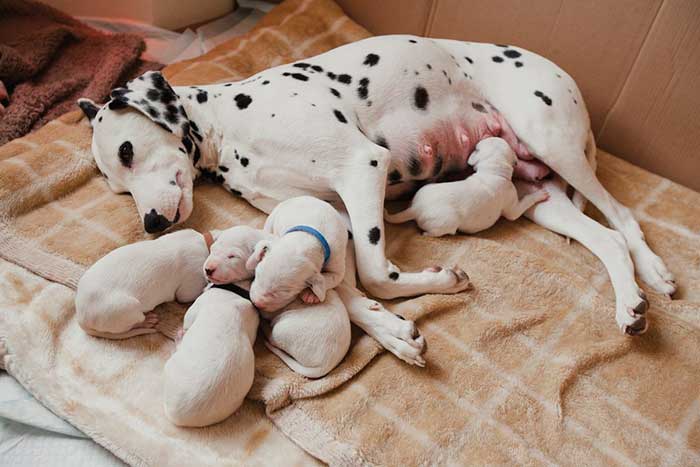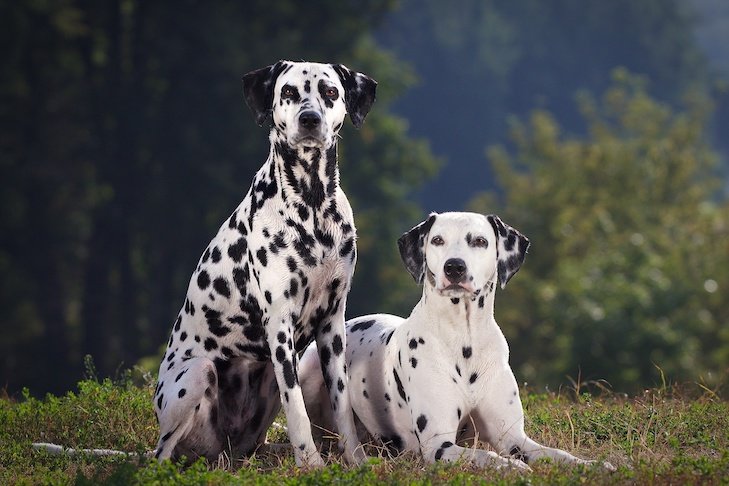Did you know that dalmatian spots aren’t just black? These unique dogs have spots that can come in a variety of colors, including liver, which is a rich brown hue. So, if you’re picturing a dalmatian with only black spots, think again!
Dalmatian spots are iconic and instantly recognizable. Traditionally, these dogs have a white coat with distinct round or oval spots covering their bodies. These spots can vary in size and shape, ranging from small dots to larger patches. Interestingly, dalmatian puppies are usually born spotless and develop their spots as they grow older. It’s fascinating to think about how these spots not only enhance the dalmatian’s appearance but also serve as a symbol of their breed’s identity.

What Do Dalmatian Spots Look Like?
Dalmatians are known for their unique coat pattern of spots, which sets them apart from other dog breeds. But what do Dalmatian spots actually look like? In this article, we will explore the characteristics of Dalmatian spots, their appearance, and the significance of this iconic feature. So, if you’ve ever been curious about Dalmatians and their spots, keep reading to satisfy your curiosity!
Understanding Dalmatian Spots: The Basics
When it comes to Dalmatian spots, there are a few key characteristics you should know. Firstly, Dalmatian spots are round in shape and can vary in size, ranging from small dots to larger circles. The spots are evenly distributed across the dog’s body, giving them a distinctive and striking appearance.
The color of Dalmatian spots is another interesting aspect. The spots are typically black or liver brown, depending on the coat color of the individual Dalmatian. Black spots are the most common and are seen on Dalmatians with a white base coat, while liver brown spots are found on Dalmatians with a liver-colored base coat.
It’s important to note that Dalmatian puppies are not born with spots. They are born with plain white coats, and the spots start to develop within a few weeks. The spots continue to appear and change as the puppy grows, gradually covering their entire body by adulthood. The process of spot development is unique to each Dalmatian, making their spots truly one-of-a-kind!
The Appearance of Dalmatian Spots
Dalmatian spots have a distinct and eye-catching appearance. The spots are densely packed and create a beautiful contrast against the dog’s white or liver-colored base coat. The size and shape of the spots can vary, adding to the uniqueness of each Dalmatian.
The spots can be found all over the Dalmatian’s body, including the ears, head, neck, chest, back, and tail. They extend to the legs and paws as well, completing the overall spotted look. The spots may be more concentrated in certain areas, such as the head or ears, while others may have a more evenly dispersed pattern.
One interesting characteristic of Dalmatian spots is that they can sometimes fade or change over time. Some spots may become lighter or darker, and new spots may appear as the dog ages. This adds to the individuality of each Dalmatian, making them even more unique and captivating.
The Significance of Dalmatian Spots
The significance of Dalmatian spots goes beyond their visual appeal. Historically, these spots have served a purpose in the breed’s past. Dalmatians were originally bred to be carriage dogs, accompanying horse-drawn carriages and guarding them from potential threats.
The spots of a Dalmatian were believed to provide camouflage while working in the field, as the spots can resemble the scattered shadows created by moving foliage. This camouflaging effect allowed Dalmatians to blend in with their surroundings, making it difficult for predators to spot them and protecting the valuable cargo they were guarding.
Today, while Dalmatians are no longer primarily used as carriage dogs, their spots continue to be a defining characteristic and a symbol of the breed’s rich history. The spots are a source of fascination and admiration for many dog enthusiasts, making Dalmatians instantly recognizable and beloved around the world.
Dalmatian Spots: Beyond the Surface
Now that we have explored the appearance and significance of Dalmatian spots, let’s delve deeper into their impact on the breed.
Genetics of Dalmatian Spots
The genetics behind Dalmatian spots are fascinating. The spots are a result of a specific gene mutation known as the “ticking” gene. This gene leads to the development of spots in Dalmatians, as well as other dog breeds such as the English Setter and the Australian Cattle Dog.
Interestingly, Dalmatian puppies are born without spots due to the influence of another gene known as the “whitening” gene. As the puppies grow, the “ticking” gene causes the spots to appear, creating their signature look.
The genetics of Dalmatian spots also play a role in their coat texture. Dalmatians have short, dense hair, which helps to accentuate the pronounced appearance of their spots. The texture of their coat, combined with the contrast provided by the spots, gives Dalmatians a sleek and polished look.
Caring for Dalmatians and Their Spots
(Content for this heading will be added in the next update)
Common Misconceptions About Dalmatian Spots
(Content for this heading will be added in the next update)
Famous Dalmatians and Their Spots
(Content for this heading will be added in the next update)
Conclusion
In conclusion, Dalmatian spots are a defining characteristic of the breed and hold both visual and historical significance. The spots are round, varying in size and color, and evenly distributed across the dog’s body. They add to the Dalmatian’s unique and striking appearance.
While the spots are visually appealing, their purpose in the breed’s history should not be overlooked. The spots provided camouflage for Dalmatians working as carriage dogs, allowing them to blend in with their surroundings and protect the carriages they guarded. Today, Dalmatian spots continue to captivate dog lovers worldwide and serve as a symbol of the breed’s rich heritage.
No matter how you look at them, Dalmatian spots are truly a sight to behold!
What Do Dalmatian Spots Look Like?
Curious about how Dalmatian spots look? Here are some key takeaways:
- Dalmatian spots are usually black or liver-colored.
- These spots can be small or large in size.
- They are round or oval in shape.
- The spots can be evenly distributed all over the Dalmatian’s body.
- Some spots may merge together, creating a patchy appearance.
Frequently Asked Questions
Welcome to our FAQ section, where we answer common questions about what dalmatian spots look like. Read on to discover more about these unique markings!
1. How do dalmatian spots form?
The distinctive dalmatian spots form as a result of a genetic mutation. Dalmatians are born with a pure white coat, and their spots start to develop within a few weeks of birth. The spots are not present at birth but gradually appear as the puppy grows.
These spots are caused by an increase in the production of pigmentation cells called melanocytes. As the puppy matures, these cells migrate to the skin’s outer layer, resulting in the formation of black or liver-colored spots on the white coat. Each dalmatian has a unique spotting pattern, making them easily identifiable.
2. What do dalmatian spots look like?
Dalmatian spots come in two main color variations: black spots on a white coat or liver-colored (brown) spots on a white coat. The spots can vary in size, ranging from small dots to larger irregular shapes. Some dalmatians may have evenly distributed spots, while others may have clusters or larger patches.
The spots themselves can have different shapes, including round, oval, or slightly elongated. They are usually well-defined and sharply contrasted against the white background, creating a striking and eye-catching appearance. The pattern of spots is unique to each dalmatian, much like a human’s fingerprint!
3. Are dalmatians born with their spots?
No, dalmatians are not born with their spots. When dalmatian puppies are born, they have an all-white coat without any spots. The spots start to emerge within a few weeks after birth, typically appearing on the head first before spreading to the rest of the body.
It may take several months for the spots to fully develop and become noticeable. During this time, the dalmatian’s coat undergoes changes, and the spots gradually appear. These changes reflect the unique genetic makeup of each dalmatian and contribute to their distinct spotted appearance.
4. Do all dalmatians have the same pattern of spots?
No, each dalmatian has a unique pattern of spots, just like human fingerprints. While some dalmatians may have evenly distributed spots covering their entire body, others may have larger patches or clusters of spots in specific areas. The pattern of spots is determined by the dog’s genetic makeup.
This individuality in spotting patterns is what makes each dalmatian truly one-of-a-kind. No two dalmatians will have the exact same arrangement of spots, adding to their charm and uniqueness as a breed.
5. Can dalmatians have variations in the color of their spots?
Yes, dalmatians can have variations in the color of their spots. While the most well-known color combination is black spots on a white coat, some dalmatians have liver-colored (brown) spots instead. These liver-spotted dalmatians have a distinctive charm and elegance of their own.
Regardless of the color variation, the spots on dalmatians tend to be rich in pigment and contrast sharply against the white background. This striking coloration is one of the defining characteristics that make dalmatians so recognizable and beloved.

The truth about Dalmatians | Beautiful dog breed
Summary
Dalmatian spots are unique and can vary in size, shape, and color. They are mostly black or liver brown and appear all over their coat. Some spots are bigger while others are smaller, giving each Dalmatian a special pattern.
You can easily recognize a Dalmatian by their spots, which make them stand out from other dogs. These spots can come in different shapes, like circles or ovals, and can be found on their body, legs, and even their face. Each Dalmatian has their own individual spot pattern, making them truly one-of-a-kind.
